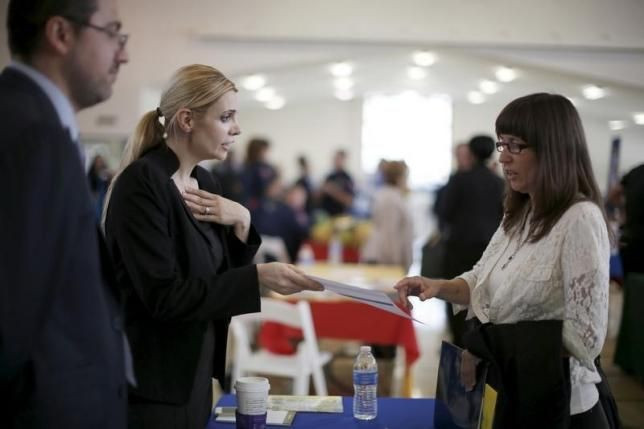US Job Growth Seen Regaining Steam, Keeping Fed Rate Hike On Track

U.S. job growth likely rebounded last month and the unemployment rate probably dropped to a near seven-year low, signs of a pick up in economic momentum that could keep the Federal Reserve on track to hike interest rates this year.
Nonfarm payrolls likely jumped by 224,000 after increasing by 126,000 in March, according to a Reuters survey of economists. The jobless rate is seen dropping one-tenth of a percentage point to 5.4 percent, which would be the lowest since May 2008.
The Labor Department will release its closely followed employment report at 8:30 a.m. (1230 GMT) on Friday.
"Our view is that we get a pretty clear signal that the first-quarter soft patch was just that, a temporary soft patch that will subside and we will get a bit of a bounce back," said Bricklin Dwyer, an economist at BNP Paribas in New York.
The economy wobbled in the first quarter and may have even contracted as it was buffeted by bad weather, port disruptions, a strong dollar and deep spending cuts by energy firms.
Payroll growth could surprise on the upside, economists said, given that there were five weeks between the March and April payroll survey periods, rather than the more-normal four.
They said it was unlikely the model the government uses to iron out seasonal fluctuations would completely eliminate upward bias from the extra week, which could boost payrolls by between 40,000 and 70,000.
"In the past twenty years, Aprils with employment report survey weeks that were five weeks after the March survey week instead of four have shown regular upside in job growth relative to the surrounding trend," said Ted Wieseman, an economist at Morgan Stanley in New York.
On the flip side, a report on Wednesday that showed private employment gains in April were the smallest in more than a year could augur a weaker-than-expected figure.
Even if payrolls beat expectations, the Fed is likely to hold off tightening monetary policy for at least a few more months given the headwinds to growth from the dollar and spending cuts in the energy sector, and a desire among officials to get a firmer fix on the economy's trajectory.
SEPTEMBER LIFT-OFF
"The Fed is on track to ultimately go in September. They are looking for continued improvement in labor markets and if we continue to get payroll growth in the low 200,000 and declining unemployment rate, that would be enough to meet their task," said Lewis Alexander, chief economist at Nomura Securities International in New York.
The U.S. central bank has kept overnight interest rates near zero since December 2008.
A drop in the unemployment rate would push it within a whisker or two of the 5.0 percent to 5.2 percent range that most Fed officials consider consistent with full employment.
The report is expected to show steady gains in wage growth. Average hourly earnings are forecast rising by 0.2 percent in April, which would take the year-on-year gain to 2.3 percent - the largest increase since August 2013.
"The fundamentals for the consumer are very good ... and that bodes well for the broader economy," said Michael Hanson, senior economist at Bank of America Merrill Lynch in New York.
Last month, the government said the economy expanded by only a 0.2 percent annual rate in the first quarter, but a report earlier this week showing a wider-than-forecast trade deficit suggests GDP actually shrank.
Economists looked for a broad-based acceleration in job growth in April, with the exception of the mining sector, where a plunge in crude oil prices has undercut energy production.
Schlumberger, the world's No.1 oil-field services provider, said last month it would cut a further 11,000 jobs, bringing total layoffs this year to 20,000. Baker Hughes and Halliburton have also announced thousands of redundancies.
Construction and manufacturing employment, which declined in March, probably bounced back in April. The strong dollar, however, remains a drag on factories.
© Copyright IBTimes 2025. All rights reserved.





















